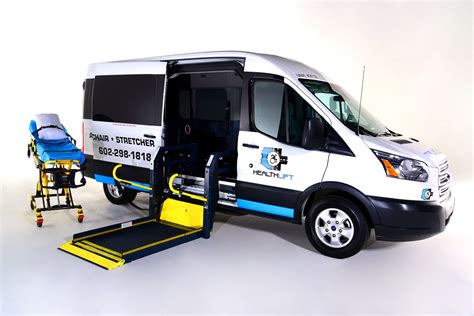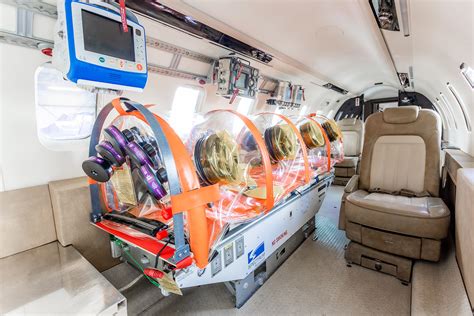What Is A Medical Transport

Medical transport, a crucial component of the healthcare system, plays a pivotal role in ensuring timely and efficient patient care. It involves the safe and secure transportation of patients, medical personnel, and equipment from one location to another, often bridging the gap between healthcare facilities and the community. This multifaceted service is designed to cater to a diverse range of medical needs, from emergency responses to non-emergency transfers, making it an indispensable aspect of modern healthcare.
The Evolution of Medical Transport

The concept of medical transport has evolved significantly over the years, from the early days of horse-drawn ambulances to the highly sophisticated, specialized vehicles and aircraft of today. This evolution has been driven by advancements in technology, a better understanding of patient needs, and the increasing demand for efficient, rapid medical responses.
Historically, the primary mode of medical transport was the ambulance, a vehicle designed specifically for the emergency transportation of patients. The first ambulances were rudimentary, often little more than horse-drawn carts, but they played a crucial role in getting medical assistance to those in need. As medical knowledge and technology advanced, so did the design and capabilities of ambulances, incorporating features like stretchers, medical equipment, and specialized communication systems.
In modern times, medical transport has expanded beyond traditional ambulances. It now encompasses a wide range of vehicles and services, each tailored to specific medical needs. These include ground ambulances, air ambulances (both helicopter and fixed-wing aircraft), specialized patient transport vehicles, and even innovative solutions like drone-based medical deliveries.
The evolution of medical transport has also seen a shift towards more specialized services. While emergency responses remain a critical aspect, there is now a greater focus on non-emergency medical transport. This includes patient transfers between healthcare facilities, repatriation of patients to their home countries, and even the transportation of organs and other medical supplies.
Types of Medical Transport and Their Applications

Ground Ambulances
Ground ambulances are the most common form of medical transport. They are designed for emergency and non-emergency patient transportation, equipped with advanced medical equipment and trained personnel. These vehicles are a familiar sight in most communities, responding to 911 calls and transferring patients between healthcare facilities.
Ground ambulances are typically staffed by Emergency Medical Technicians (EMTs) or Paramedics, who are trained to provide immediate medical care during transportation. They are equipped with a range of medical devices, including defibrillators, oxygen therapy equipment, and advanced life support systems. The vehicles are designed to be highly maneuverable, allowing for quick response times in emergency situations.
Air Ambulances
Air ambulances, including helicopters and fixed-wing aircraft, provide a rapid and efficient means of medical transport over long distances or in areas with limited ground access. They are particularly crucial in emergency situations where time is of the essence, such as remote or rural areas, or when transporting patients between cities.
Helicopter ambulances, often referred to as "Air 911," are designed for rapid response and can land in areas where traditional ambulances cannot. They are equipped with advanced medical equipment and are staffed by highly skilled medical teams, including doctors and nurses. These helicopters are a vital link in the emergency response chain, providing life-saving care in critical situations.
Fixed-wing aircraft, on the other hand, are used for longer-distance medical transports, often for patients who require specialized care or equipment that may not be readily available at their current location. These aircraft are equipped with advanced medical capabilities, including intensive care units and specialized patient monitoring systems.
Specialized Patient Transport Vehicles
Specialized patient transport vehicles are designed for non-emergency medical transports. These vehicles are equipped to provide a comfortable and safe environment for patients during long-distance transfers. They are often used for patient repatriation, transfers between healthcare facilities, and for patients who require ongoing medical care during their journey.
These vehicles are typically staffed by healthcare professionals, such as nurses or medical attendants, who provide continuous care and monitoring during the transport. They are equipped with a range of medical equipment, including stretchers, oxygen therapy systems, and basic life support equipment.
Innovative Solutions: Drone-Based Medical Deliveries
In recent years, the healthcare industry has embraced innovative technologies like drones for medical transport. Drones are being utilized for the rapid delivery of medical supplies and equipment, particularly in remote or hard-to-reach areas. This technology has the potential to revolutionize medical transport, especially in emergency situations where time is critical.
Drones can carry medical payloads, such as defibrillators, vaccines, and blood samples, to locations that are difficult to access by traditional means. This technology is particularly promising in rural or disaster-stricken areas, where it can provide life-saving medical interventions in a matter of minutes.
Performance Analysis and Metrics
Evaluating the performance of medical transport services is crucial to ensuring their effectiveness and efficiency. Various metrics are used to assess different aspects of these services, including response times, patient outcomes, and cost-effectiveness.
| Metric | Description |
|---|---|
| Response Time | The time taken from the receipt of a call for assistance to the arrival of the medical transport at the scene. This metric is critical in emergency situations, where rapid response can significantly impact patient outcomes. |
| Patient Outcomes | The success rate of medical interventions provided during transport, measured by patient survival rates, improvement in medical conditions, and patient satisfaction. This metric provides an overall indication of the quality of care provided by medical transport services. |
| Cost-Effectiveness | The efficiency of medical transport services in terms of cost, considering factors such as operational costs, equipment maintenance, and staffing. This metric is important for ensuring the sustainability and accessibility of medical transport services. |

Response times are a critical metric for emergency medical transport services. The ability to respond quickly can be the difference between life and death for many patients. Ground ambulances, due to their ability to navigate through traffic and access most locations, typically have the fastest response times. However, air ambulances are also vital in reducing response times, especially in remote or rural areas.
Patient outcomes are a key indicator of the success of medical transport services. The survival rates and improvement in medical conditions post-transport provide a direct measure of the effectiveness of the care provided. This metric is particularly important for critical care transports, where the advanced medical equipment and skilled personnel on board can significantly impact patient survival and recovery.
Cost-effectiveness is a crucial consideration for medical transport services, especially in the context of limited healthcare resources. While the primary focus is on providing high-quality care, the sustainability of these services is also essential. Efficient use of resources, including staff, equipment, and fuel, is vital to ensure that medical transport services remain accessible and affordable for all who need them.
Future Implications and Innovations
The future of medical transport holds exciting possibilities, driven by technological advancements and a growing understanding of patient needs. Several emerging trends and innovations are set to shape the landscape of medical transport, enhancing its efficiency, accessibility, and patient-centricity.
Advancements in Telemedicine and Remote Monitoring
The integration of telemedicine and remote monitoring technologies is poised to revolutionize medical transport. These technologies enable medical professionals to provide real-time care and support to patients during transport, even when physical presence is not possible. This is particularly beneficial for long-distance transports, where the ability to continuously monitor and provide care can significantly improve patient outcomes.
Telemedicine allows medical teams to assess patient conditions remotely, provide necessary interventions, and make informed decisions about patient care. Remote monitoring systems, integrated into medical transport vehicles, can continuously track vital signs and other health parameters, alerting medical staff to any changes or anomalies. This real-time data can guide medical interventions, ensuring that patients receive the most appropriate and timely care.
Enhanced Patient Comfort and Safety
Future medical transport services are likely to place a greater emphasis on patient comfort and safety. This includes the development of more ergonomic and comfortable transport vehicles, equipped with advanced safety features and medical equipment. These innovations aim to minimize patient discomfort during transport, particularly for long-distance or critical care transfers.
Ergonomic stretchers and seating, designed with patient comfort in mind, are already being incorporated into medical transport vehicles. These innovations reduce the risk of pressure injuries and provide a more comfortable journey for patients. Additionally, advanced safety features, such as collision avoidance systems and enhanced lighting, are being integrated to ensure a safer transport experience.
Expanding the Reach of Medical Transport
One of the most significant future implications for medical transport is the potential to expand its reach, particularly in remote or underserved areas. This includes the continued development and deployment of drone-based medical delivery systems, as well as the exploration of other innovative solutions.
Drones, as mentioned earlier, have the potential to revolutionize medical transport in remote areas. They can rapidly deliver essential medical supplies, equipment, and even provide real-time medical support, making a significant impact on patient care and outcomes in these hard-to-reach locations. Additionally, the development of specialized transport vehicles, designed for challenging terrains and weather conditions, could further extend the reach of medical transport services.
Conclusion

Medical transport is a critical aspect of the healthcare system, ensuring that patients receive timely and efficient care, regardless of their location. From the early days of horse-drawn ambulances to the advanced technologies of today, medical transport has evolved to meet the growing demands and complexities of modern healthcare.
The various types of medical transport, including ground ambulances, air ambulances, and specialized patient transport vehicles, each play a unique and vital role in patient care. As we look to the future, the continued development and innovation in medical transport hold the promise of further improving patient outcomes, expanding access to healthcare, and enhancing the overall patient experience.
What is the primary role of medical transport in the healthcare system?
+Medical transport plays a crucial role in ensuring timely and efficient patient care. It involves the safe and secure transportation of patients, medical personnel, and equipment from one location to another, bridging the gap between healthcare facilities and the community.
How has medical transport evolved over time?
+The evolution of medical transport has seen a transformation from horse-drawn carts to highly sophisticated, specialized vehicles and aircraft. This evolution has been driven by advancements in technology, a better understanding of patient needs, and the increasing demand for efficient, rapid medical responses.
What are the different types of medical transport, and what are their applications?
+The types of medical transport include ground ambulances, air ambulances (both helicopter and fixed-wing aircraft), specialized patient transport vehicles, and innovative solutions like drone-based medical deliveries. Each type is designed for specific medical needs, whether it’s emergency responses, non-emergency transfers, or specialized patient care.
How are the performance and effectiveness of medical transport services evaluated?
+The performance and effectiveness of medical transport services are evaluated using various metrics, including response times, patient outcomes, and cost-effectiveness. These metrics provide a comprehensive assessment of the quality, efficiency, and accessibility of medical transport services.
What are the future implications and innovations in medical transport?
+The future of medical transport is characterized by advancements in telemedicine and remote monitoring, enhanced patient comfort and safety, and the expansion of medical transport’s reach, particularly in remote or underserved areas. These innovations aim to improve patient outcomes, enhance accessibility, and provide a more patient-centric transport experience.


